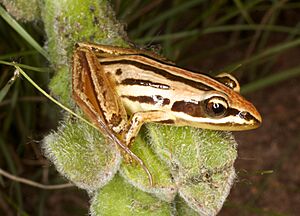Striped stream frog facts for kids
Quick facts for kids Striped stream frog |
|
|---|---|
 |
|
| Conservation status | |
| Scientific classification | |
| Synonyms | |
|
The Striped stream frog (scientific name: Strongylopus fasciatus) is a special type of frog that lives only in southern Africa. You might also hear it called the striped grass frog or long-toed frog. It belongs to the frog family called Pyxicephalidae.
Contents
What Does It Look Like?
The Striped stream frog is a small frog with long legs and a pointy nose. It's easy to spot because of the yellow and brown stripes running down its back. Its legs also have dark stripes.
Its belly is white, and male frogs have yellow throats. Their eyes have horizontal pupils, which means the dark part of their eye is shaped like a line. This frog also has very long toes. When it crouches down, the fourth toe on its back feet reaches past its front feet!
What Sound Does It Make?
The Striped stream frog makes a sharp "pip" sound. It might make just one "pip" or a series of three or four quick "pips" in a row.
Where Does It Live?
You can find the Striped stream frog in many parts of southern Africa. It lives from the Western Cape Province in South Africa, all the way east to the borders of Lesotho and Eswatini. It also lives north into Zimbabwe, western Mozambique, and southwestern Zambia. Scientists are still checking if it lives in Botswana. In central South Africa, it's found in specific areas, reaching as far west as the eastern Free State.
Its Home Environment
The Striped stream frog can live in many different places, from grassy areas to forests. It prefers areas that get more than 500mm of rain each year. You will rarely find it far from water that stays around all the time.
In the grassy mountains of South Africa, these frogs like to breed near grassy streams, or in the reeds along rivers and wetlands called vleis. They don't mind if humans are around. You can even find them in irrigation canals, water reservoirs, parks, and gardens!
Life Cycle and Habits
Striped stream frogs mostly breed during the southern winter. Colder temperatures seem to make them start breeding. Males usually begin calling in late February, but sometimes as early as January. The busiest time for calling is in March, April, and May. They stop calling by November. Sometimes, in summer, a cold front can make them start calling again for a short time.
Male frogs call from the edge of the water or from high spots in reeds and grass. If there aren't many frogs, the males might call by themselves. But if there are lots of frogs, they can form large groups called choruses. In these groups, males might be only a few centimeters apart!
The female frog lays her eggs one by one in shallow water, usually along the edges of grassy water bodies. The eggs quickly get covered with bits of plants and dirt, which makes them very hard to see. We don't know exactly how many eggs a female lays, but scientists think it's not a very large number compared to other frogs. The baby frogs, called tadpoles, turn into small froglets after about 4 to 5 months.
Is It Safe?
The Striped stream frog is a common species and is found in many places. This means it is not currently in danger of disappearing. However, in 2004, some of these frogs caught in Kenton on Sea tested positive for a fungus. This fungus causes a disease called chytridiomycosis, which can make frogs sick.


